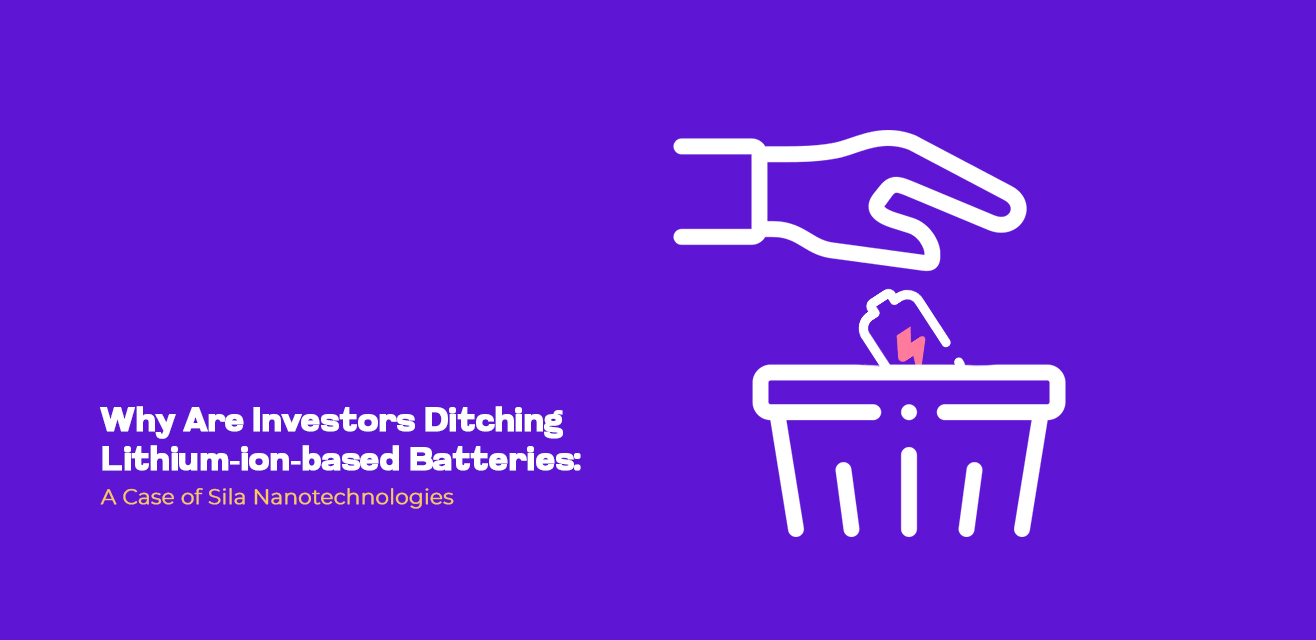Why Are Investors Ditching Lithium-ion-based Batteries: A Case of Sila Nanotechnologies
Lithium-ion batteries have powered everything from smartphones to electric vehicles. However, their efficacy can no longer meet manufacturer demands. Amidst health and environmental concerns, trust in lithium-ion-based batteries is falling. So, investors are looking for credible alternatives.
Sila Nanotechnologies, an innovative battery manufacturer, is dedicated to solving this issue. So, it has raised $375 million to finish the construction of its factory and begin the roll-out of better batteries.
In this article, we will look at the problems and limitations of lithium-ion batteries. You will also learn the science behind Sila’s silicon-based technology and its advantages.
Overview of Lithium-ion Batteries and Their Problems
The history and use of Lithium-ion Batteries
Research into Lithium-ion batteries started as a way to replace non-rechargeable batteries. In the 1970s, John Goodenough and other researchers discovered that lithium cobalt oxide (LCO) offers higher energy voltage and is more stable in the air. This discovery led to the manufacturing of the first Li-ion battery.
However, John Goodenough’s solution did not solve the persistent flammability issue. Another scientist, Rachid Yazami, would later address the problem by developing a new method to detect early-stage short circuits in batteries. Akira Yoshino’s contribution influenced the development and stability of modern Lithium-ion batteries.
Lithium-ion (Li-ion) batteries have not always been as inefficient as now. Until recently, they were regarded as essential to technological development. However, over 30 years later, Li-ion batteries have become redundant for modern needs. They have also become well-known for their spectacular failures, such as explosions, overheating, short lifecycles, swelling, and more.
Despite the epic failures, Li-ion batteries still hold a large percentage of the market. And this is prompting investors to look for more efficient energy sources. These batteries are used in almost all modern technology products, including:
- Electric vehicles,
- Smartphones
- Laptops
- Cameras
- Solar panels
- Pacemakers
- Aircrafts S
- Spacecraft.
Limitations of using Lithium-ion Batteries
Lithium-ion batteries have been declining for some time now. They can no longer handle the technological needs of the 21st century. For example, the Samsung Galaxy Note 7 explosion and excessive battery drain from the iOS 11.4 update.
Here are some limitations of lithium-ion batteries:
1. High cost
Lithium-ion batteries are expensive to produce. This is due to the scarcity of raw materials. And the sophisticated processes required to make batteries safe for commercial use.
2. Safety concerns
Lithium-ion batteries are prone to random explosions and overheating. Some of the causes are:
i. improper maintenance
ii. poor manufacturing standards
iii. thermal runway
iv. external factors.
3. Environmental impact
Lithium production, extraction, and disposal can cause disruption to the environment. Lithium can lead to ecological and health damage if it is not properly handled.
4. Degradation
Lithium-ion batteries naturally lose efficacy and capacity to store energy over time. This loss is due to structural damage, temperature, state of charge, and load profile.
5. Swelling
Swelling is a common problem for lithium-ion batteries. These products swell due to
i. persistent overcharging
ii. damaged membranes
iii. wrong voltage usage
iv. manufacturing defects.
If the battery is not immediately replaced, it can cause functional problems to the device and potentially lead to safety hazards.
Sila Nanotechnologies: A Game Changer

Lithium-ion batteries are unable to meet modern technological requirements. But Sila Nanotechnologies is here to change the game and revolutionize batteries.
Sila Nanotechnologies was founded by Gene Berdichevsky, a former Tesla number 7. The company’s mission is to develop and manufacture advanced battery materials. This will enable the widespread adoption of renewable energy sources.
Berdichevsky was an influential figure in Tesla and helped develop the battery tested on some of its first EVs. One of Tesla’s earlier problems was that its lithium-ion batteries often caught fire. Berdichevsky was instrumental in finding a solution to the problem. While solving it, he discovered the diminishing returns of Li-ion batteries.
To address this issue, Berdichevsky resigned from Tesla and returned to Stanford University. After graduating, he partnered with Gleb Yushin and Alex Jacobs to start Sila Technologies. Sila’s proprietary technology uses silicon nanotechnology to create high-performance battery materials. These materials will ensure increasing energy density, safety, and charging speed. The technology also costs less than the average lithium-ion battery.
In 2012, the company received its first federal grant from the ARPA-E to produce next-gen battery material. It also signed a development partnership agreement with BMW. After years of perfecting their technology for industrial use and safety, Sila filed a patent and began a partnership with Mercedes-Benz.
In 2020, the company launched its next-generation material in the WHOOP 4.0 and closed $600 million in Series F funding. In 2023, Silas announced the availability of Titan Silicon, its first anode product, and signed a deal with Panasonic Energy.
The company has also raised $375 million to complete the construction of its U.S. factory. This factory will scale up the production of its next-generation battery technology for customers.
Sila’s Technological Innovations
Sila has made significant progress in improving battery technology. The company developed silicon-based nanoparticles that form high-capacity anodes. The batteries are robust and porous enough to take any swelling that affects lithium-ion batteries. They are also stronger and will last longer.
Some of the technological innovations that Silas has brought into battery development are:
- Development of nano-composite silicon
- The development of silicon powder which grants better efficacy to batteries. It also improves their charging speed, energy density, and capacity.
- Development of Titan Silicon anode
- Development of a silicon-based anode that is five times lighter and two times smaller than graphite-based anodes
- Development of NCS anode to maximize lithium-ion energy density with low swell comparable to graphite
Through these innovations, Sila has improved battery technology for the future. It has also facilitated a 20% to 40% improvement in energy capacity compared to Li-ion models. The company’s silicon anode material can store more energy per unit of weight and volume.
Additionally, higher energy density comes with smaller and more efficient batteries. This will make them more versatile and compatible with several products and applications. The technology promises improved safety, faster charging, and lower costs.
The Advantages of Sila Nanotechnologies’ Battery Technology
The following are the advantages of Sila Nanotechnologies battery:
1. Higher energy density
Sila batteries have higher capacity, improved conductivity, and provide more efficient ion transfer. The integration of silicon-based anode materials improves energy density while balancing safety.
The new batteries boast up to 20% improved energy density. This is unlike lithium-ion batteries, which can’t hold on to more without swelling. This technology will empower new tech products and fix excessive battery draining. The charging time, heating, and lifespan will also improve.
2. Longer range
Sila technologies have also improved the viability and practicality of electric vehicles. This battery allows more range on a single charge than average lithium-ion batteries. It is estimated that electric cars powered by this technology can travel up to 100 miles after a full charge.
3. Faster charging
The silicon-based material in Sila batteries allows for more conductivity. With more conductivity, there will be faster charging time and charging efficiency. Devices using this product can charge from 10% to 80% in 20 minutes.
4. Lower cost
Lithium-ion batteries are expensive because they are sourced from scarce materials. However, Sila’s silicon-based anode materials are readily available and cheaper to obtain. The lower cost of production could reduce the costs of new technologies powered by these batteries.
5. Improved safety
Sila batteries have better safety measures, and elements factored into production. They have similar safety features to graphite anodes. This helps reduce the risk of overheating (thermal runway), fires, and explosions.
6. Scalability
A key component of Sila battery technology is that it does not significantly change the design of batteries. Instead, its silicon-anode innovation provides better storage capacity, conductivity, and safety.
These batteries can be easily integrated into existing manufacturing processes. So, manufacturers don’t need to implement new procedures just to integrate these new batteries. Sila’s new battery technology will also scale production and allow companies to meet growing demands.
7. Environmental benefits
Sila’s new battery technology generates about 50-70% lower carbon emissions than graphite production. The reduced carbon footprint contributes to a greener future. Using silicon ensures that new battery usage does not compromise global environmental standards.
Conclusion
Sila Nanotechnologies has revolutionized battery technology with its silicon-based anode material. The new battery technology improves energy density, charging speed, safety, and environmental sustainability.
The company is in partnership with industry giants like BMW and Mercedes.
It has also secured an additional $375 million in funding to complete the construction of its U.S. factory. This factory will scale up the production and development of next-gen battery materials.
The new battery technology is expected to reduce the overall cost of production and the price of gadgets in the market. It will also reduce dependence on scarce resources and Chinese supply chains. The end goal, however, is to make the electrification of modern technology viable and practicable.

